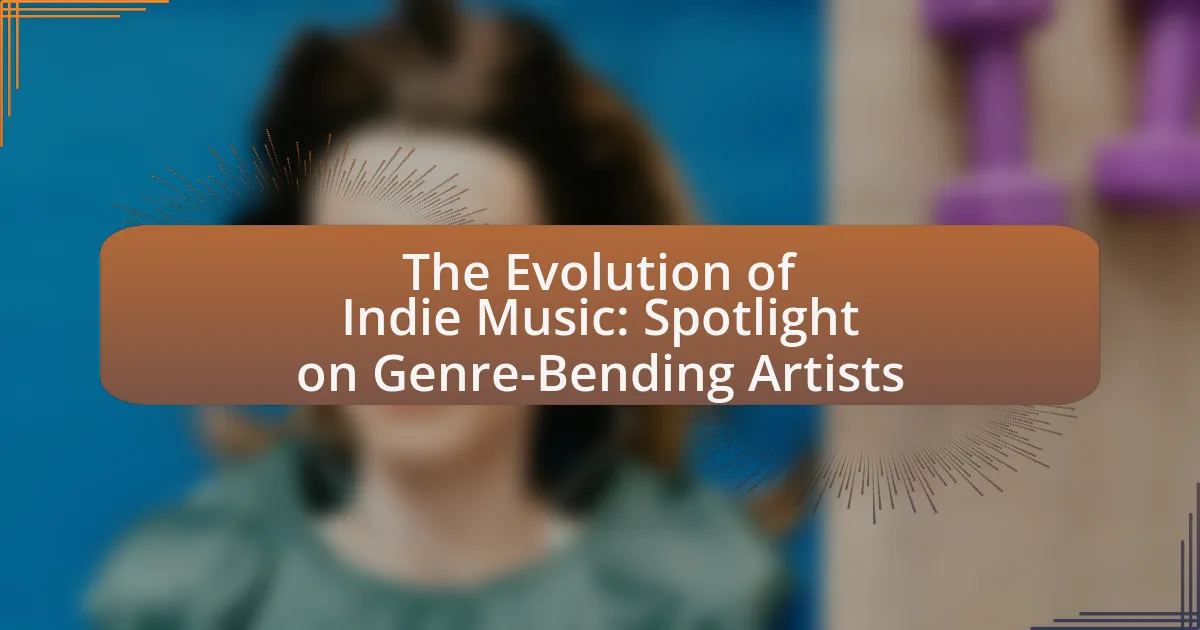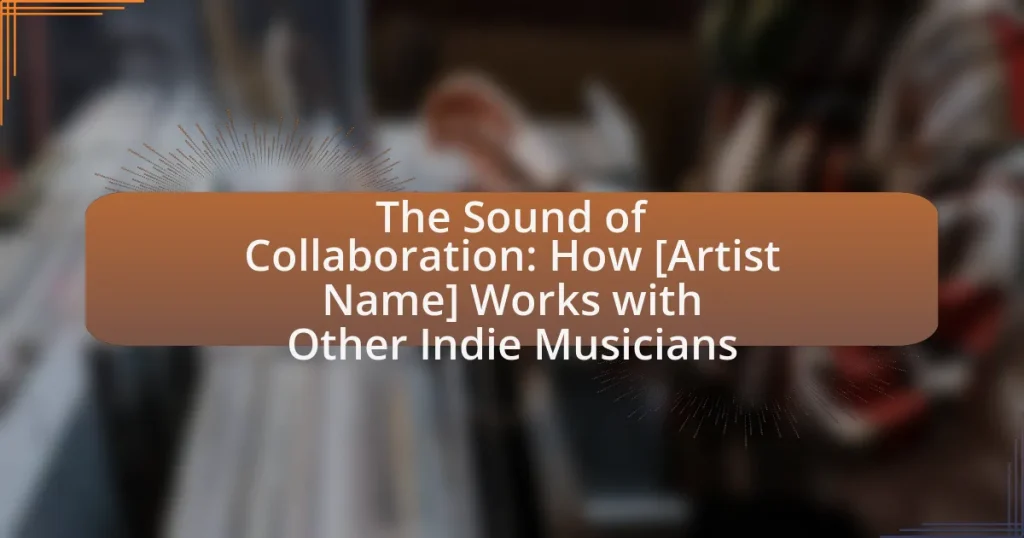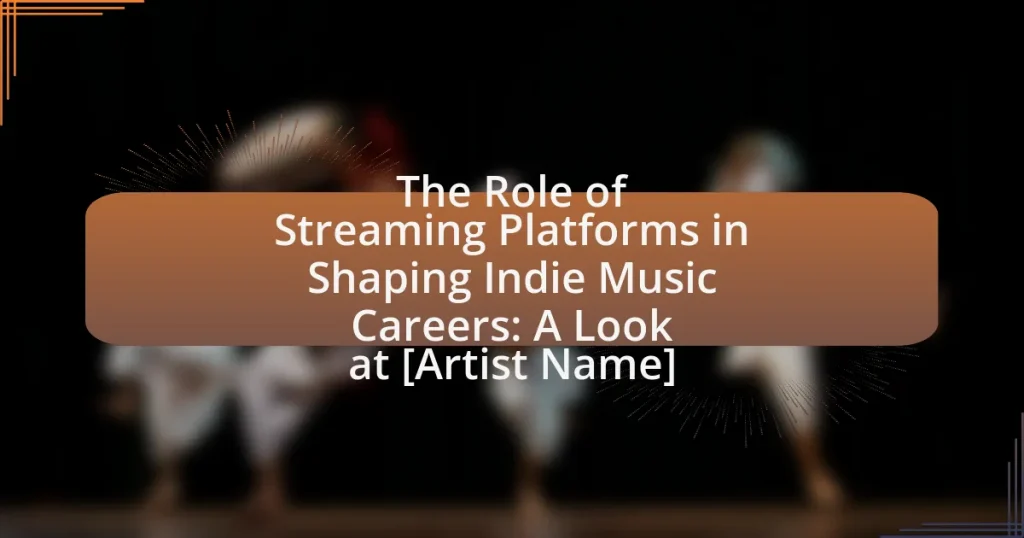The article examines the evolution of indie music, highlighting its transition from a niche genre in the 1980s to a mainstream force by the 2020s, driven by technological advancements and the rise of independent labels. It explores the significance of genre-bending, showcasing how artists like Sufjan Stevens and Billie Eilish challenge traditional classifications by blending diverse musical styles. Key historical events, such as the punk rock movement and the advent of the internet, are discussed as influential factors in shaping the indie music landscape. Additionally, the article addresses the role of streaming platforms and social media in promoting genre-bending artists and outlines future trends in indie music, emphasizing the importance of diversity and collaboration in fostering innovation.

What is the Evolution of Indie Music?
The evolution of indie music began in the 1980s as artists sought to create music outside the mainstream commercial music industry. Initially characterized by a DIY ethic, indie music gained traction through independent record labels and underground scenes, allowing artists to maintain creative control. By the 1990s, the genre expanded significantly with the rise of bands like Nirvana and Radiohead, who blended alternative rock with various influences, leading to greater visibility and acceptance of indie music in popular culture. The 2000s saw the emergence of digital platforms, which further democratized music distribution, enabling genre-bending artists to reach wider audiences without major label support. This shift has resulted in a diverse landscape where indie music now encompasses a wide range of styles, from folk to electronic, reflecting the eclectic tastes of contemporary listeners.
How has indie music changed over the decades?
Indie music has evolved significantly over the decades, transitioning from a niche genre in the 1980s to a mainstream force by the 2020s. In the 1980s, indie music was characterized by its DIY ethos and underground distribution, with bands like R.E.M. and The Smiths gaining traction through independent labels. The 1990s saw the rise of lo-fi aesthetics and the emergence of subgenres such as indie rock and indie pop, with artists like Pavement and Belle and Sebastian shaping the sound.
By the 2000s, the internet revolutionized the distribution of indie music, allowing artists like Arcade Fire and Death Cab for Cutie to reach wider audiences without major label support. The 2010s introduced genre-blending, as artists like Bon Iver and Sufjan Stevens incorporated elements from folk, electronic, and hip-hop, further expanding the boundaries of indie music.
As of the 2020s, indie music continues to thrive, with platforms like Bandcamp and Spotify enabling diverse voices and experimental sounds, reflecting a broader cultural acceptance and integration of indie artists into the mainstream music landscape.
What key historical events influenced the evolution of indie music?
Key historical events that influenced the evolution of indie music include the rise of punk rock in the 1970s, the advent of affordable recording technology in the 1980s, and the emergence of the internet in the 1990s. The punk rock movement, characterized by its DIY ethos, encouraged independent artists to create and distribute their music outside of major record labels. The introduction of affordable recording equipment allowed musicians to produce high-quality recordings at home, further democratizing music production. Additionally, the internet revolutionized music distribution, enabling indie artists to reach global audiences without traditional gatekeepers, which significantly contributed to the growth and diversification of the indie music scene.
How have technological advancements impacted indie music production?
Technological advancements have significantly democratized indie music production, enabling artists to create high-quality recordings with minimal resources. The rise of affordable digital audio workstations (DAWs) like Ableton Live and GarageBand has allowed independent musicians to produce, mix, and master their music from home studios, reducing reliance on expensive recording studios. Additionally, the proliferation of online distribution platforms such as Bandcamp and SoundCloud has facilitated direct access to audiences, allowing indie artists to reach global listeners without traditional gatekeepers. According to a 2020 report by the International Federation of the Phonographic Industry, independent labels accounted for 40% of global recorded music revenue, highlighting the impact of these technological changes on the indie music landscape.
Why is genre-bending significant in indie music?
Genre-bending is significant in indie music because it allows artists to break traditional boundaries and create innovative sounds that reflect diverse influences. This creative freedom fosters originality, enabling musicians to experiment with various genres, such as blending rock with electronic or folk with hip-hop. The significance is underscored by the rise of artists like Bon Iver and Sufjan Stevens, who have successfully merged styles, leading to critical acclaim and a broader audience. This trend not only challenges the conventional music industry norms but also encourages listeners to embrace a wider range of musical experiences, ultimately enriching the indie music landscape.
What defines genre-bending in the context of indie music?
Genre-bending in the context of indie music is defined by the blending of multiple musical styles and genres to create innovative and unique sounds. This practice allows artists to transcend traditional genre boundaries, often incorporating elements from rock, pop, electronic, folk, and hip-hop, among others. For example, artists like Bon Iver and Sufjan Stevens have successfully merged indie folk with electronic music, showcasing the versatility and creativity inherent in genre-bending. This approach not only reflects the diverse influences of contemporary musicians but also resonates with audiences seeking fresh and eclectic musical experiences.
How do genre-bending artists challenge traditional music classifications?
Genre-bending artists challenge traditional music classifications by blending elements from multiple genres, creating innovative sounds that defy conventional categorization. For instance, artists like Billie Eilish incorporate pop, electronic, and indie influences, resulting in music that cannot be easily classified into a single genre. This fusion not only expands the sonic palette but also reflects the diverse influences and cultural backgrounds of the artists, as seen in the rise of subgenres like trap-pop and folk-rap. The Billboard charts have increasingly recognized these hybrid styles, indicating a shift in listener preferences and industry standards, further validating the impact of genre-bending on traditional classifications.
What role do independent labels play in the evolution of indie music?
Independent labels are crucial in the evolution of indie music as they provide artists with creative freedom and financial support outside the constraints of major record labels. These labels often prioritize artistic expression over commercial viability, allowing genre-bending artists to experiment and innovate. For instance, labels like Sub Pop and Matador Records have historically championed diverse sounds, helping to launch the careers of influential indie musicians such as Nirvana and Liz Phair. This support fosters a vibrant music scene that encourages the exploration of new genres and styles, contributing significantly to the overall growth and diversification of indie music.
How do independent labels support genre-bending artists?
Independent labels support genre-bending artists by providing creative freedom and resources that major labels often restrict. These independent labels typically prioritize artistic expression over commercial viability, allowing artists to explore and blend multiple genres without the pressure to conform to mainstream expectations. For instance, independent labels like Sub Pop and XL Recordings have successfully nurtured artists such as Beck and Adele, who defy traditional genre classifications. This support includes funding for recording, marketing, and distribution, enabling genre-bending artists to reach diverse audiences while maintaining their unique sound.
What are the differences between independent and major labels in promoting indie music?
Independent labels typically offer more creative freedom and personalized marketing strategies for indie music, while major labels provide extensive resources and broader distribution networks. Independent labels often focus on niche audiences and grassroots promotion, allowing artists to maintain artistic control, as seen with labels like Sub Pop and their support for bands like Nirvana. In contrast, major labels, such as Universal Music Group, leverage significant financial backing to promote artists through mainstream channels, resulting in wider reach but often at the cost of artistic compromise. This distinction highlights the varying approaches to artist development and market penetration in the indie music landscape.
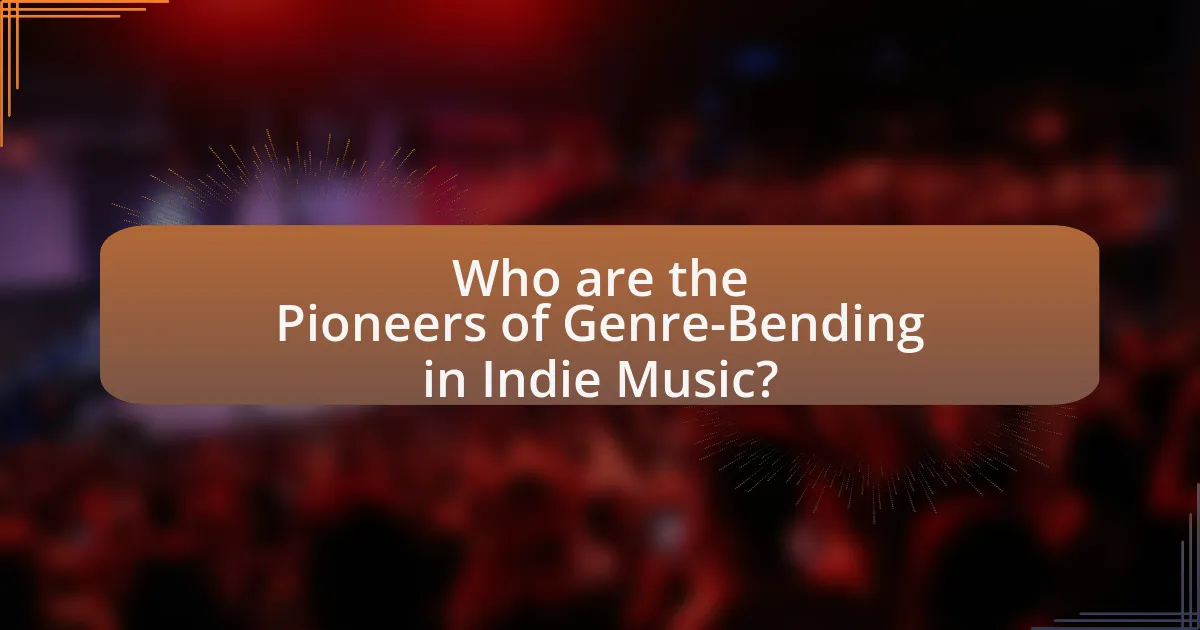
Who are the Pioneers of Genre-Bending in Indie Music?
The pioneers of genre-bending in indie music include artists like Beck, who fused rock, hip-hop, and folk elements in his 1994 album “Mellow Gold,” and Sufjan Stevens, known for blending orchestral arrangements with indie folk in albums like “Illinois.” These artists have significantly influenced the genre by challenging traditional boundaries and incorporating diverse musical styles, which has led to a broader acceptance of genre-blending in the indie music scene.
What artists are considered genre-bending pioneers in indie music?
Artists considered genre-bending pioneers in indie music include Sufjan Stevens, Björk, and Animal Collective. Sufjan Stevens is known for blending folk, orchestral, and electronic elements, particularly in albums like “Illinois.” Björk has consistently fused electronic, pop, and avant-garde styles, as evidenced in her album “Homogenic.” Animal Collective combines elements of psychedelia, pop, and experimental music, notably in their album “Merriweather Post Pavilion.” These artists have significantly influenced the indie music landscape by pushing genre boundaries and creating innovative sounds.
How did these artists influence the indie music landscape?
These artists significantly influenced the indie music landscape by introducing innovative sounds and blending genres, which expanded the boundaries of what indie music could encompass. For instance, artists like Sufjan Stevens and Bon Iver incorporated elements of folk, electronic, and orchestral music, creating a more diverse sonic palette that inspired countless musicians to experiment with their own styles. This genre-bending approach not only attracted a wider audience but also encouraged a culture of collaboration and cross-genre experimentation within the indie scene, leading to the emergence of sub-genres such as indie pop and indie rock. The impact of these artists is evident in the rise of platforms like Bandcamp and SoundCloud, which have democratized music distribution and allowed for greater artistic freedom, further shaping the indie music landscape.
What unique sounds did these pioneers introduce to the genre?
Pioneers of indie music introduced unique sounds such as lo-fi production, unconventional song structures, and eclectic instrumentation. For instance, artists like Neutral Milk Hotel incorporated elements of folk, punk, and psychedelia, creating a distinct sound characterized by raw, emotional vocals and innovative use of instruments like the singing saw. Similarly, bands like Animal Collective blended electronic music with traditional folk elements, resulting in layered harmonies and experimental soundscapes. These innovations have significantly shaped the genre, influencing countless artists and expanding the boundaries of indie music.
How have contemporary genre-bending artists emerged in the indie scene?
Contemporary genre-bending artists have emerged in the indie scene by blending diverse musical styles, creating innovative sounds that defy traditional genre classifications. This emergence is facilitated by the accessibility of digital platforms, which allow artists to experiment and share their work widely. For instance, artists like Billie Eilish and Sufjan Stevens incorporate elements from pop, electronic, folk, and hip-hop, showcasing the fluidity of genre boundaries. The rise of streaming services has also contributed to this trend, as algorithms promote eclectic playlists that encourage listeners to explore various genres, further supporting genre-blending artists in gaining visibility and recognition.
What characteristics define the sound of modern genre-bending artists?
Modern genre-bending artists are defined by their eclectic sound that combines elements from multiple musical genres, creating a unique auditory experience. This blending often includes the integration of diverse influences such as electronic, hip-hop, rock, and folk, resulting in innovative compositions that defy traditional genre boundaries. For instance, artists like Billie Eilish and Lil Nas X exemplify this characteristic by merging pop with electronic and country elements, respectively, showcasing versatility and creativity. The rise of digital production tools has further facilitated this genre fusion, allowing artists to experiment with sounds and styles that were previously difficult to combine.
How do contemporary artists draw inspiration from their predecessors?
Contemporary artists draw inspiration from their predecessors by reinterpreting and blending established musical styles and techniques. For instance, many genre-bending indie musicians incorporate elements from classic rock, folk, and electronic music, creating innovative sounds that pay homage to earlier artists while pushing boundaries. This practice is evident in the works of artists like Sufjan Stevens, who combines orchestral arrangements reminiscent of classical composers with modern indie sensibilities, showcasing a direct lineage to past musical traditions. Additionally, the use of sampling and remixing in contemporary music reflects a dialogue with historical genres, allowing artists to create new narratives from existing material.
Why is diversity important among genre-bending artists?
Diversity is important among genre-bending artists because it fosters innovation and creativity, allowing for the blending of different musical styles and cultural influences. This cross-pollination leads to unique sounds that can resonate with a broader audience, enhancing the overall richness of the music landscape. For instance, artists like Billie Eilish and Lil Nas X have successfully merged elements from pop, hip-hop, and country, demonstrating how diverse influences can create chart-topping hits. Furthermore, research from the University of Southern California indicates that diverse teams in creative fields produce more original ideas, underscoring the value of varied perspectives in music creation.
How does diversity in genre-bending contribute to the richness of indie music?
Diversity in genre-bending significantly enhances the richness of indie music by fostering innovation and broadening artistic expression. This blending of styles allows artists to experiment with various musical elements, resulting in unique sounds that challenge traditional genre boundaries. For instance, artists like Sufjan Stevens combine folk, classical, and electronic influences, creating a distinct auditory experience that attracts diverse audiences. Furthermore, a study by the University of Southern California found that genre-blending in music leads to increased listener engagement and emotional connection, highlighting its impact on the indie music landscape. This diversity not only enriches the music itself but also cultivates a vibrant community of listeners who appreciate varied artistic interpretations.
What impact does cultural background have on genre-bending in indie music?
Cultural background significantly influences genre-bending in indie music by shaping artists’ musical styles, themes, and collaborations. Artists from diverse cultural backgrounds often incorporate traditional elements, instruments, and rhythms into their music, creating unique fusions that challenge conventional genre boundaries. For example, artists like M.I.A. blend South Asian sounds with hip-hop and electronic music, reflecting her Sri Lankan heritage while appealing to global audiences. This blending not only enriches the indie music landscape but also fosters cross-cultural dialogue, as seen in the rise of genres like Latin trap, which merges reggaeton with hip-hop influences. Such cultural intersections highlight the dynamic nature of indie music, demonstrating how cultural backgrounds can drive innovation and redefine genre classifications.
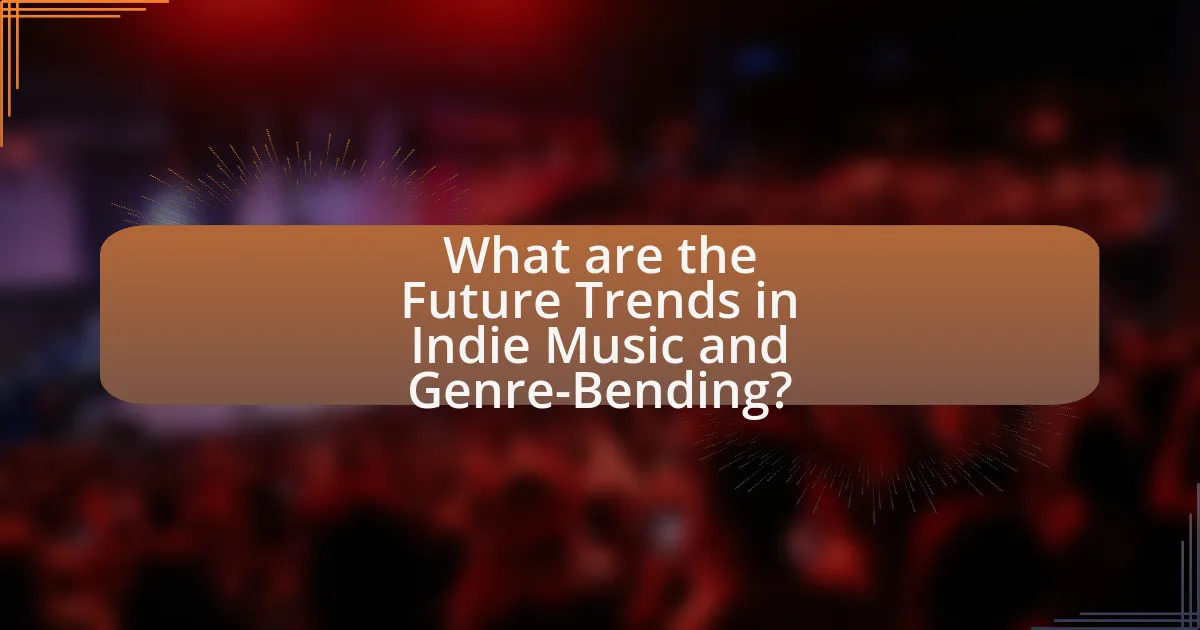
What are the Future Trends in Indie Music and Genre-Bending?
Future trends in indie music and genre-bending include increased collaboration across diverse musical styles and the rise of technology-driven production methods. Artists are increasingly blending genres such as pop, rock, hip-hop, and electronic music, creating unique sounds that appeal to broader audiences. For instance, the success of artists like Billie Eilish and Lil Nas X demonstrates how genre-blending can lead to mainstream recognition while maintaining indie roots. Additionally, advancements in digital tools and platforms enable independent musicians to experiment with sounds and reach global audiences, further promoting genre fusion. This trend is supported by data showing that genre-blending tracks often perform better on streaming platforms, indicating a shift in listener preferences towards innovative and eclectic music styles.
How is technology shaping the future of indie music?
Technology is shaping the future of indie music by enabling artists to produce, distribute, and promote their work independently. Digital audio workstations (DAWs) allow musicians to create high-quality recordings at home, reducing the need for expensive studio time. Streaming platforms like Spotify and Bandcamp provide accessible distribution channels, allowing indie artists to reach global audiences without traditional record label support. Additionally, social media platforms facilitate direct engagement with fans, fostering community and enhancing marketing efforts. According to a 2021 report by the International Federation of the Phonographic Industry, independent music accounted for 40% of global music revenue, highlighting the significant impact of technology on the indie music landscape.
What role do streaming platforms play in promoting genre-bending artists?
Streaming platforms play a crucial role in promoting genre-bending artists by providing them with a global audience and facilitating the discovery of diverse musical styles. These platforms, such as Spotify and Apple Music, utilize algorithms that recommend music based on user preferences, allowing genre-bending artists to reach listeners who may not typically explore their unique sound. For instance, Spotify’s “Discover Weekly” and “Release Radar” playlists have been instrumental in introducing users to new and unconventional artists, leading to increased streams and visibility. Additionally, the accessibility of these platforms enables genre-bending artists to bypass traditional gatekeepers in the music industry, allowing for a more democratized approach to music distribution and promotion. This shift has resulted in a significant rise in the popularity of artists who blend multiple genres, as evidenced by the success of artists like Billie Eilish and Lil Nas X, who have achieved mainstream recognition through their innovative sounds.
How are social media and digital marketing influencing indie music trends?
Social media and digital marketing are significantly shaping indie music trends by enabling artists to reach wider audiences and engage directly with fans. Platforms like Instagram, TikTok, and Spotify allow indie musicians to promote their work without traditional gatekeepers, leading to increased visibility and the ability to cultivate dedicated fan bases. For instance, TikTok has been instrumental in popularizing songs through viral challenges, with tracks like “Old Town Road” by Lil Nas X gaining immense popularity through user-generated content. Additionally, digital marketing strategies, such as targeted ads and social media campaigns, allow indie artists to tailor their outreach, resulting in more effective engagement with specific demographics. This shift has democratized music promotion, allowing genre-bending artists to experiment and innovate, ultimately influencing the overall landscape of indie music.
What emerging genres are likely to influence the future of indie music?
Emerging genres likely to influence the future of indie music include bedroom pop, hyperpop, and lo-fi hip-hop. Bedroom pop, characterized by its DIY production and intimate sound, has gained traction through platforms like SoundCloud and TikTok, allowing artists to reach wider audiences without traditional label support. Hyperpop, known for its eclectic mix of pop, electronic, and experimental sounds, has seen a rise in popularity with artists like 100 gecs, pushing the boundaries of mainstream pop. Lo-fi hip-hop, with its chill beats and nostalgic samples, has created a significant online community, particularly on streaming platforms, fostering a new wave of indie artists who blend genres and styles. These genres reflect the evolving landscape of indie music, driven by digital accessibility and cultural shifts.
How do current musical trends indicate the direction of indie music evolution?
Current musical trends indicate that indie music is evolving towards greater genre-blending and experimentation. This shift is evidenced by the rise of artists who incorporate elements from various genres, such as electronic, hip-hop, and folk, into their indie sound. For instance, artists like Billie Eilish and Sufjan Stevens have successfully merged pop and electronic influences with traditional indie aesthetics, showcasing a willingness to defy genre boundaries. Additionally, data from the 2022 Billboard charts revealed that indie artists who embraced genre fusion saw increased streaming numbers, highlighting a consumer preference for innovative sounds. This trend suggests that the future of indie music will likely continue to embrace diversity and cross-genre collaboration.
What new collaborations are expected to arise in the genre-bending space?
New collaborations in the genre-bending space are expected to emerge between artists from diverse musical backgrounds, such as hip-hop, electronic, and indie rock. This trend is driven by the increasing popularity of cross-genre experimentation, as evidenced by successful projects like Lil Nas X’s “Old Town Road,” which blends country and rap, and Billie Eilish’s incorporation of pop and alternative elements. The rise of digital platforms facilitates these collaborations, allowing artists to connect and create innovative sounds that challenge traditional genre boundaries.
What practical tips can aspiring genre-bending artists follow?
Aspiring genre-bending artists should actively explore diverse musical influences to create unique sounds. By listening to various genres, artists can identify elements that resonate with them and incorporate those into their work. For instance, artists like Billie Eilish and Lil Nas X have successfully blended pop, hip-hop, and country, showcasing the potential of genre fusion. Additionally, collaborating with musicians from different backgrounds can enhance creativity and lead to innovative compositions. Engaging in live performances across various genres can also help artists understand audience reactions and refine their style. This approach not only broadens their musical palette but also establishes a distinct artistic identity in the evolving indie music landscape.
How can artists effectively blend genres while maintaining their unique identity?
Artists can effectively blend genres while maintaining their unique identity by intentionally integrating elements from various styles that resonate with their personal experiences and artistic vision. This approach allows artists to create a distinctive sound that reflects their individuality while drawing from diverse musical influences. For instance, genre-bending artists like Billie Eilish and Lil Nas X have successfully merged pop, hip-hop, and electronic elements, showcasing their unique identities through innovative production techniques and lyrical themes. Their success demonstrates that a thoughtful combination of genres, rooted in personal authenticity, can lead to a fresh and recognizable artistic expression.
What resources are available for indie artists looking to innovate musically?
Indie artists looking to innovate musically can access a variety of resources, including digital audio workstations (DAWs), online collaboration platforms, and educational content. DAWs like Ableton Live and FL Studio provide tools for music production and experimentation with sound. Online platforms such as Splice and Soundtrap facilitate collaboration with other musicians, allowing for genre-blending and innovative approaches. Additionally, websites like Coursera and MasterClass offer courses on music theory, production techniques, and songwriting, enabling artists to expand their skills and creativity. These resources collectively support indie artists in pushing musical boundaries and exploring new genres.
